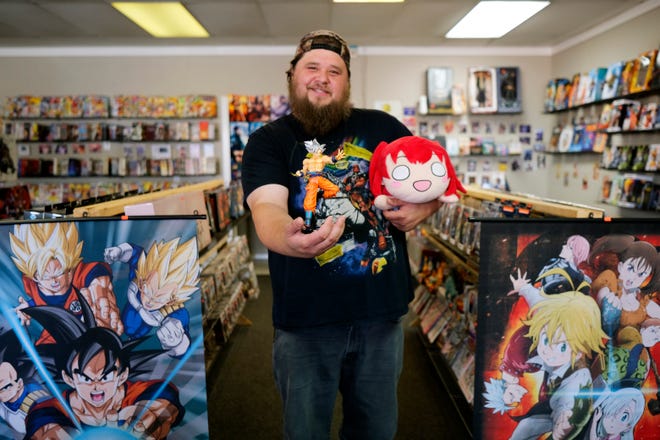As I took my seat between two 20-something-year-old men and a couple with two teens, I couldn’t help but notice the excitement in the air of the theater before last weekend’s top box-office draw.
It has been a tradition of mine and my best friend, Trevor Wakefield, to catch Japanese animated film showings for nearly a decade, so the Aug. 19 premiere of “Dragon Ball Super: Super Hero” was not something I would’ve missed ― not even for two other friends’ birthday parties.
Most people say watching an “Avengers” movie is an event, but “Dragon Ball” films are my “Avengers”-level events. Nothing compares to being surrounded by a vocal fandom, all there for the same purpose. To roar as a chiseled martial artist adorned with tall, spiky black hair and orange karategi goes toe-to-toe with a short-tempered feline deity over ice cream. To laugh as a reformed, green-skinned demon with forehead antennae plots a quick-witted scheme against a duo of superhero robots. To cheer as a peace-loving scholar unlocks his potential and ascends to a new level of planet-busting power.
Based on the turnout at Quail Springs AMC that night, it was clear many share similar feelings as Trevor and me. In my row alone, I was surrounded by a spectrum of die-hard fans: one Black and one Asian man about my age directly to my left, a Hispanic man and woman with two teenage children to Trevor’s right, and a few seats over a solitary gray-haired man who appeared to be in his late 50s.
Later that weekend, when I saw headlines astounded that “Dragon Ball Super: Super Hero” had beaten the Idris Elba vehicle “Beast” at the box office, I wasn’t surprised. Its No. 1 status follows a trend we’ve seen develop in recent years, where Japanese animated films (or “anime”) boast ticket sales rivaling their live-action counterparts released at the same time.
Fortnite x Dragon Ball:How to get the Kamehameha
Anime proving to be lucrative entertainment
For example, “Jujutsu Kaisen 0” ― the cinematic prequel to the namesake anime series on the Crunchyroll streaming service ― earned $19 million during St. Patrick’s Day weekend back in March, bested only by “The Batman.” And last year, “Mugen Train,” a sequel film to the smash-hit series “Demon Slayer,” brawled directly with a live-action film adaptation of the “Mortal Kombat” video game, setting records with a $21 million haul that eventually led to the highest-grossing Japanese film of all time.
The newest “Dragon Ball Super” film opened on 3,900 screens in North America, the widest-ever release for an anime yet, and topped the charts with $20.1 million in ticket sales. “Beast” took in nowhere near as much, with $11 million.
The renaissance of anime films and television series has been steadily building over many years, as fans worldwide of director Hayao Miyazaki have made Studio Ghibli an internationally acclaimed studio for four decades. But a host of factors contributed to the most recent surge of interest, with a massive crowd of newcomers to the scene joining longtime community mavens.
Nia Ramsey, a 23-year-old graduate student in professional writing at the University of Oklahoma, witnessed the growth herself, after the COVID-19 pandemic forced countless people to stay home. In 2020, popular streaming services, like Netflix and Hulu, saw an overnight spike in subscribers, with millions of people suddenly having the free time to explore shows they hadn’t before.
“I feel like what’s happened is that a lot of older teens and younger adults were so profoundly bored, they may have just clicked on an anime title they’d see on streaming services,” Ramsey said. “And after they’d spent some time watching it, they realized, ‘Oh, this is actually pretty cool,’ and that it may not have fit their preconceived beliefs of what anime was. It wasn’t just Japanese SpongeBob.”

Best adult animated series:Cartoons aren’t just for kids
Anime gained popularity through strong storytelling, tackling mature topics
Ramsey has been an avid fan of anime for many years, since she first watched “Pokemon” as a little girl. A Black member of the LGBTQ community, she draws creative inspiration for her fantasy and romance stories from her favorite anime shows. One of her favorites, “Revolutionary Girl Utena,” sparked a realization that she was lesbian during her late middle school years.
“Strong female characters who just happened to be gay was very normalized in the show,” Ramsey said. “It was not only entertainment, it was also intellectually stimulating, and it was gay, so for me, I got all of my bases covered with that show.”
One more classic that Ramsey especially appreciates is “Sailor Moon.” In this groundbreaking, female-centric anime series, the titular schoolgirl leads the Sailor Soldiers in defense of the Earth against villains hellbent on stealing the magical Silver Crystal.
Despite its immense popularity overseas, “Sailor Moon” faced censorship obstacles when the show was first imported onto U.S. airwaves in the 1990s, including changing Sailors Uranus and Neptune from lesbian lovers into cousins. Ramsey felt this rushed change implied an inappropriate relationship between two family members, but this would not have been the case had the U.S. version been faithful to the Japanese original.
“God forbid we just show two girls in love, holding hands,” Ramsey said, laughing at the absurd lengths the English dub went to avoid LGBTQ representation. “I will never get over that until the day I die.”
For decades, Japanese anime has tackled themes and narratives that Western animated media ― pigeonholed by Disney fairy-tale frameworks or children’s entertainment restrictions ― has long been reluctant or unable to touch. Audiences who crave different styles of storytelling are finding a lot to love in the imaginative worlds of anime.
One classic example is “Akira,” the 1988 sci-fi anime action film, iconic for its take on a futuristic and tech-driven Tokyo marred by militaristic control and terroristic violence. Considered the “Blade Runner” of anime, “Akira” has been endlessly imitated but never quite replicated, and a live-action adaptation, shopped around for years, has never gotten off the ground.
Another contemporary example is the acclaimed series “Attack on Titan,” which has been broadcast for nearly 10 years. In this dystopian anime, mankind is forced to live behind cities with giant walls during a multi-generational conflict with colossal man-eating Titans. It uses this fantastical setting to deconstruct complex issues like the dehumanizing realities of war and racism.
‘A revolutionary change’:What is Kyoto Animation, the anime studio hit by arson?
More shops spring up in Oklahoma City amid anime craze
Chris D’Andrea, who manages a local shop called Anime Zone, said the rise of anime in recent years might also be owed to other types of genre-bending, adult-oriented American animation, such as “Rick & Morty” and “Regular Show.” These series, already heavily influenced by anime, also create a circular effect by pushing boundaries and inspiring audiences to seek out similar shows.
“Even though shows like ‘Rick & Morty’ are comedies, they also have a lot of deep storylines and very creative ideas that are just mind-blowing,” D’Andrea said. “Once you start watching animated shows like that, then you’ll realize it’s more like a movie with human actors, except that it’s drawn.”
D’Andrea, 36, has been a member of the anime community for more than 20 years. He’s excited by the new generation of fans embracing the medium, which he told me directly informed owner Jason Anderson’s decision to launch Anime Zone in southwest Oklahoma City earlier this summer.
Open Wednesdays through Sundays, Anime Zone’s busiest Saturdays have seen 30 to 40 people come into the stores for merchandise and “manga,” the comics on which many anime are based.
“Whenever I was little, I had ‘Transformers’ and ‘G.I. Joe’ to watch,” D’Andrea said. “Kids don’t really have that to watch now, and I think all of the parents that are my age are starting to show anime to their kids, too. This is really the next generation’s ‘Transformers’ or ‘G.I. Joes.’”
D’Andrea said the underlying themes in the highest-rated anime shows, like “My Hero Academia” or “Demon Slayer,” encourage self-improvement and empathy, along with their spectacular action sequences. These powerful messages were what drew D’Andrea to “Dragon Ball” in the first place, he said, so it’s easy for him to see why anime continues to resonate with today’s youths.
‘We’re about your childhood’:Pauls Valley’s toy, action figure museum a joyful trip down memory lane
Anime culture a source of community for young people
Other fans told me they find the exploding popularity of anime ironic, because they were ridiculed for their interest years ago when they were teenagers.
“I had the experience of being the nerdy kid who everybody would make fun of, would call anime ‘weird,’ would laugh at and make jokes about doing the ‘Naruto’ run through the hallways,” Ramsey said. “And it’s a lot of the same people who bullied me … who are now watching anime and love it. I’m happy to see anime get all of this love and get exposed, but it’s just frustrating when you were put down for that thing that now everyone loves.”

That’s the experience of Summer Rain, too, another OU graduate. She moved to Oklahoma nearly a decade ago to finish her graduate studies in education, but she didn’t really find a community until she embraced one of her biggest interests ― “cosplaying,” the performance art of dressing up as a character from your favorite series.
“Cosplay is just kind of the next step when you love a piece of media or a specific character,” Rain said. “I think a lot of people thought I’d grow out of this back when I first started and it was more ‘niche,’ but the more I learned how to do certain skills like wig-work and sewing and working with foam, the more invested I got in getting better at all of it.”
Both Ramsey and Rain attend anime conventions, where fans from across the country gather to celebrate the medium and Japanese culture. One of the largest is A-Kon, when every year tens of thousands converge upon Irving, Texas, but our state also has its own.
OKiCon meets every New Year’s holiday in Norman, and Anime Oklahoma will hold an event Sept. 9-11 in Midwest City.
“When I talk about cosplay and conventions to new people I’ve just met, I find myself having to explain it less and less, because most people seem to have a general awareness of it now,” Rain said. “I feel like you can’t talk to younger folks now without them introducing themselves by telling you their favorite anime.”








